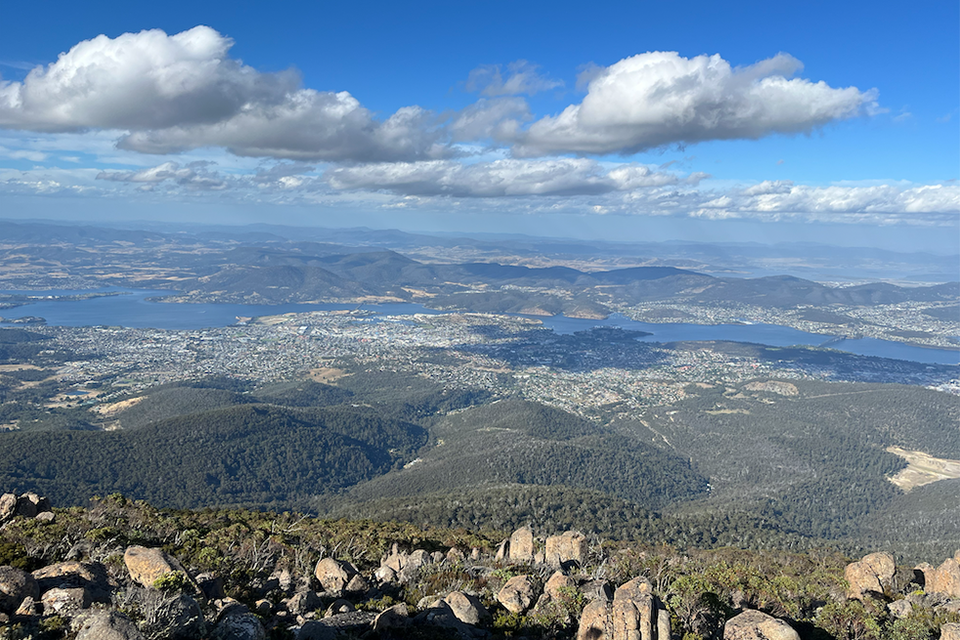One of the first things I did when I moved to Sydney, Australia was leave. Because of seasonal differences in the southern hemisphere, the Australian summer break runs during December and January, and the first academic term doesn’t start until mid February. Taking only one summer course, this change left me with a lot of free time to make plans and meet other exchange students. After several hours spent looking at possible destinations to spend a vacation, a couple of other exchange students and I finished a three day itinerary to backpack Tasmania, Australia’s southernmost territory.
Waking up at 3:30am to catch the flight, our first day started leaving Sydney and landing in Hobart, Tasmania’s capital city. It was a Saturday, which meant Hobart’s famous Salamanca Market was running, where street vendors gather to sell some of Tasmania’s finest gourmet food, woodwork, and jewelry. After grabbing some brunch in the markets, we headed over to the Royal Tasmanian Botanical Garden and did some light grocery shopping for our next few days of traveling. Later in the day, we began to make our way towards Mount Wellington (or “kunanyi” in a local Aboriginal language). The mountain has a 1300 meter elevation and one of the best views of the Hobart bay area. A nice dinner later and we found ourselves at our first hostel full of backpackers from across the world, and I quickly passed out because of our busy first day.
The second day of the trip was my personal favorite. We were initially upset when we arrived at Freycinet National Park because it was raining pretty hard - the weather in Australia can be very unpredictable at times. Because the rain made our plans of climbing Mount Amos dangerous, we set off to explore the park’s other attractions: Sleepy Bay, the Wineglass Bay Lookout trail, and Honeymoon Bay. Miraculously, around 4pm, the sun came out and we made the split decision to book it to Mount Amos. With most of the hike being on steep, slippery rock, it took a lot of sweat and problem-solving to reach the top. Once we got there, I was greeted with the most stunning panoramic view I have seen in my life; with the Freycinet peninsula below me, my fears suddenly transformed into pure happiness and relief. After a very stressful descent, we kicked back and spent the evening watching the sunset on the rocks of Bicheno, a small, peaceful coastal town (my favorite destination of the trip). We weren’t lucky enough to run into the penguin colony native to Bicheno, but we did visit the “Blowhole,” a rock formation that takes incoming waves and shoots them upwards onto the rocks.
Most of the third day was spent on the beaches of Binalong Bay, home to the whitest sand and clearest waters I have ever seen. Afterwards, we went sightseeing around the Bay of Fires, which contained more clear blue water and beautiful orange lichen-cloaked boulders. Ironically, the location does not get its name from the fiery red rocks that cover the coast, but from an English navigator who saw the fires of Aboriginal people on the beaches in the late 1700s. On the way back to Hobart, we stopped at Douglas-Apsley National Park to do the Apsley Gorge Hike, where we finally ran into Tasmania’s wildlife: wallabies, wombats, and a mysterious marsupial that (I think) could’ve been a Tasmanian devil.
Needless to say, my first backpacking experience was packed with unforgettable memories, discoveries, and sights. It was so cool to see other backpackers in their early twenties on the road, banding together to see the world. Among all the takeaways from the trip, I am continued to be inspired by how Australia integrates their Aboriginal nations in their culture. Most of the Aboriginal spiritual beliefs are intimately associated with “Country” (the land they live on) rather than a higher power. The connection between person and Country is deeply symbolic and reinforces one’s identity and sense of belonging. And after three long days of getting lost in the land they worship, I couldn’t help but embrace that spiritual connection for myself.
Dominic Savarino
GW Exchange - University of New South Wales
Spring 2023
School of Engineering & Applied Sciences
Mechanical Engineering





